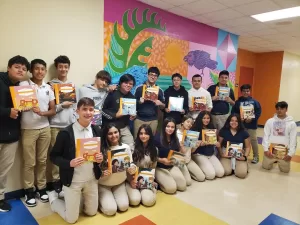|
Getting your Trinity Audio player ready...
|

Migrating to a new country, adjusting to a new school and worrying about fitting in and doing well academically are just some of the challenges faced by the roughly 18,000 foreign students enrolling in Miami-Dade County Public Schools so far this year.
Then there is the added obstacle of learning a new language and taking classes in English while accomplishing this. It can all be overwhelming.
Now there is a program that is making a big impact on how students enrolled in English for Speakers of Other Languages (ESOL) learn their new language. “Write One Give One” is an impressive supplemental tool that 20 schools in the district are using now to help ESOL students. By having students collaborate on writing an already illustrated children’s book, this learning technology is making a big difference in how well students embrace reading, writing and expressing themselves in English.
Even students in ESOL Levels 1 and 2 classes are successfully collaborating to write a children’s book in English, essentially becoming published authors by the end of the school year. All levels can participate.
“It makes my beginning English learners’ brains fly through a world of adventure and fantasy, while learning deeper aspects of the English language and standards at their linguistic level,” said Migdalia Canova Anckle, an ESOL teacher at South Dade Senior High School.
The project starts out as a soft-cover book with only pictures and a clear progression of events richly illustrated throughout the roughly 20 pages. Students collaborate to write a story in English to match the pictures, typically with two to four sentences per page.
First, they work on the book as a class (about 20 to 25 students) to learn how to get started and then they break up into small groups to collaborate on different parts of the book. Working on these books isn’t just fun for students, the assignment checks off the boxes of a number of state standards related to story elements, character development and narrative.
Students excitedly work together and share their opinions and collaborate to create plots and enhance characters, learning the elements of the English language at the same time.
The topics of these stories include bullying, acceptance of others, and helping the environment, just to name a few.
ESOL students face many challenges beyond the school day but this program helps students elevate their self-esteem, sense of belonging while intentionally enhancing academics and language.
“When I first started the school year my English was pretty bad, and I barely knew how to pronounce certain words,” said Miguel Rodriguez a seventh grade ESOL student at Jorge Mas Canosa Middle School. “But since I started working on the Write One project, I learned a lot of English. I found it to be really fun and interesting because it helped me comprehend what a writer feels.”
Dr. Melina E. Castillo-Monroy, an ESOL teacher at Jorge Mas Canosa Middle School, says she tries to convey to the students that they aren’t really starting from scratch, they can create the dialogue or plot in their native language and then translate it.
“I tell the Level 1s and 2s, they’re not coming in blank, there is a great richness in sharing their ideas and creativity,” said Castillo-Monroy when referring to students who are new to ESOL classes. “They need to know that there are a lot of things out there, experiences from their lives that they can use to do great things.”
But more than creating a book, she finds that students complement each other with their strengths. Those who have been in the program longer can guide the newer students and help them with the language as they work together. Newer students can provide fresher perspectives to the other students in return.
Castillo-Monroy has had students from Guatemala, Nicaragua, Cuba, Dominican Republic, Colombia, Ecuador and even Vietnam, and all worked well as a team. Last year, the 100 students she taught authored 44 books.
Generally, the ESOL students work on the books from November to March. All the students who participated in its creation are listed as authors and they also get to choose a title and dedication. The company, Write Brain, provides the book template, software, and then publishes all the books.
By the end of the school year, the books are published and each student gets a hardcover copy for themselves and one to share either with a local library, another elementary school or local literacy programs for other children struggling to learn English. Students feel as though they not only learned but also are teaching other children.
“This project for me personally made me feel like I love doing things for kids,” said Nicole Romero, an eighth grader at Jorge Mas Canosa Middle School, “It improved my creativity a lot and I had lots of fun planning this book and making it come true.”
One group of students gave 20 books to the Mexican American Council Literacy Project. At Hialeah’s John F. Kennedy Public Library, there is a whole section of Write One Give One books that neighborhood children can enjoy when they visit the library.
“The Write One Give One initiative not only develops academic skills, self-esteem, and self-expression,” said administrative director Ana M. Gutierrez from M-DCPS’ Office of Academics and Transformation. “But It also shows the importance paying it forward and giving back to the communities, whether it’s donating their published books to their local library or sharing their books with younger students.”
Dona DePriest is Curriculum Specialist, Bilingual and World Languages, for Miami-Dade County Public Schools.
ABOUT US:
For more Miami community news, look no further than Miami Community Newspapers. This Miami online group of newspapers covers a variety of topics about the local community and beyond. Miami’s Community Newspapers offers daily news, online resources, podcasts and other multimedia content to keep readers informed. With topics ranging from local news to community events, Miami’s Community Newspapers is the ideal source for staying up to date with the latest news and happenings in the area. Additionally, the newspaper has exclusive Miami community podcasts, providing listeners with an in-depth look into Miami’s culture. Whether you’re looking for local Miami news, or podcasts about the community, Miami’s Community Newspapers has you covered.





